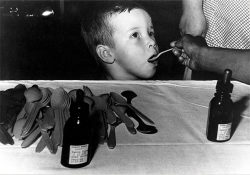... in chronological order
by Deborah Rieselman
First medical college west of the Allegheny Mountains — UC's College of Medicine was founded in 1819 as the Medical College of Ohio.
First pharmacy college west of the Alleghenies — UC's James Winkle College of Pharmacy was founded in 1850 as the Cincinnati College of Pharmacy.
First steam-powered fire engine -- Alexander Latta, faculty member, College of Applied Science's predecessor school OMI, helped develop this technology in 1852.
Nation's first salaried fire company -- Miles Greenwood, board president of the Ohio Mechanics Institute (one of the predecessor bodies in the College of Engineering and Applied Science), organized the first salaried fire company in 1853.
National Weather Service -- First observations leading to the National Weather Service came from Cincinnati Observatory director Cleveland Abbe in the 1860s.
First program of cooperative education -- Developed by engineering dean Herman Schneider in 1906. He later became the university president. Read UC Magazine article on the co-op program.
First nursing baccalaureate program — In 1916, UC's College of Nursing offered one of two of the first baccalaureate degree programs in nursing.
First electronic organ -- Invented by student Winston Kock, Eng '32, MS (Eng) '33, HonDoc '52, as his electrical engineering undergraduate thesis.
First antihistamine, Benadryl -- Chemical engineering researcher George Rieveschl (1916-2007), A&S ’37, MS (A&S) ’39, PhD (A&S) ’40, HonDoc ’56, developed it in the 1940s. Read his obituary.
Two asteroids discovered -- Asteroid "1373 Cincinnati" (discovered in 1935) is named after UC's Cincinnati Observatory, and asteroid "1751 Herget" (discovered in 1955) is named after UC professor Paul Herget, A&S '31, MA (A&S) '33, PhD (A&S) '35, HonDoc '78, who officially tracked these "minor planets" and calculated their orbits.
First heart-lung machine -- In 1951, UC cardiologist Samuel Kaplan, chemist Leland Clark and surgery professor James Helmsworth developed the world’s first functional heart-lung machine, located at Cincinnati Children’s Hospital Medical Center.
First oral polio vaccine -- Developed by medical researcher Albert Sabin, HonDoc '74, in the late 1950s. Approved for use in the United States in the late 1960s, the vaccine has saved untold millions around the world from paralytic polio and death. Read more.
First medical laser lab -- The late dermatology professor Leon Goldman, MD '29, opened the country's first such lab in 1961. He is considered the "father of laser medicine.”
First emergency medicine residency program -- Established at the university-affiliated hospital in 1970.
First degree program offered via satellite -- In 1977.
Study of birth defects pioneered — The late pediatrics professor Josef Warkany (1902–1992, MD, is regarded as the "father of teratology” (the biological study of birth defects), and his book "Congenital Malformations” (1981) is considered a medical classic, as it was the first to associate causes, not mere chance, with birth defects.
Leaders in environmental genetics — In 1982, UC opened the nation’s first federally funded Center for Environmental Genetics. The National Institute of Environmental Health Sciences supports the center's research into how genes respond to the environment. Center founder Daniel Nebert, MD, identified a pair of genes on a specific human chromosome that are key to lung cancer development.
First YAG laser used -- In 1984, neurosurgery professor John Tew was the country’s first surgeon to receive FDA approval to use the YAG laser to vaporize previously inoperable brain tumors.
Pioneering gene therapy — In 1990, under the direction of neurosurgeon Ronald Warnick, MD, UC became one of the first four centers in the country to use gene therapy for the treatment of recurring brain tumors.
Heart failure gene identified — In 2002, a UC team received international attention when it identified two genes that convey a risk of heart failure 10 times greater than that faced by people who do not carry the gene. By far, the greater risk was in African-Americans.
See list of alumni inventors and innovators.
— compiled by Deborah Rieselman
